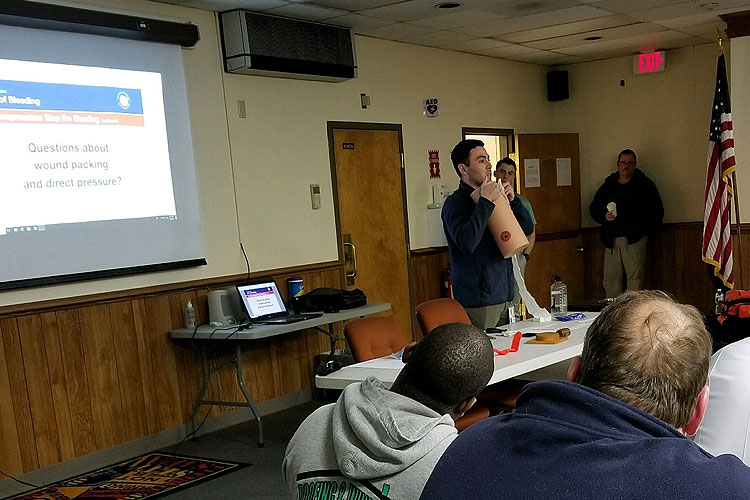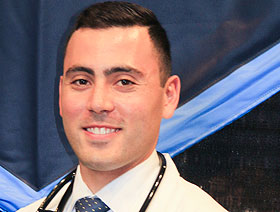

Above photo by Gregory Guevara
Article by Jeremy Fridling
What Is Stop The Bleed?
Four months after 26 people were killed at Sandy Hook Elementary School in Newtown, Connecticut, in 2012, the American College of Surgeons called a meeting of senior leaders in the communities of medicine, law enforcement, emergency medical services, fire-rescue, and the military in Hartford. Dubbed the Joint Committee to Create a National Policy to Enhance Survivability from Intentional Mass-Casualty and Active Shooter Events, the group was tasked with generating policies that would improve victim survivability at future traumatic events. This meeting and the three that ensued led to the creation of the Hartford Consensus papers. The papers set forth recommendations for changes in policy, procedure, and education with the goal of minimizing loss of life in mass casualty events.
One such recommendation, out of the Hartford Consensus III: Implementation of Bleeding Control, called for empowering members of the public to be involved in lifesaving actions. Traditionally, trauma care has been delivered by the established systems of emergency medical services and hospital care. However, the leading cause of preventable death in many of the recent mass casualty events has been exsanguination, and many of the patients have bled to death before the arrival of prehospital care personnel. The committee called for the creation of “immediate responders,” converting minorly injured or uninjured bystanders into actors and empowering them to provide lifesaving hemorrhage control. The committee also advocated for increased hemorrhage control education for professional responders and expanded public access to hemorrhage control equipment.
While Tactical Combat Casualty Care (TCCC) has been taught in the military and law enforcement worlds for several years and Tactical Emergency Casualty Care (TECC) has become popular with fire-rescue and EMS in recent times, no course existed to teach laypeople the way CPR is taught. The American College of Surgeons worked with the National Association of Emergency Medical Technicians to create the Bleeding Control Basic class, a one-hour long course based on TCCC and TECC principles designed to provide people of all levels of medical training with the knowledge, skills, and motivation to save lives by treating life-threatening hemorrhage. Specifically, the class teaches how to control bleeding using direct pressure, wound packing, and tourniquet application. Since 2015, the bleeding control course has been delivered to more than 100,000 people in every state in America and in multiple countries worldwide. More than 10,000 instructors have been certified.
RELATED: Mass-Shooting Incidents: Planning and Response | Active Shooter Response: Rescue in the Warm Zone | Fire/EMS at Active-Shooter Incidents | Active-Shooter Incidents: Planning Your Response
The Stop The Bleed Campaign came out of President Obama’s Presidential Policy Directive 8 for National Preparedness and is endorsed by the Department of Homeland Security. A new campaign, National Stop The Bleed Day, aims to organize a bleeding control course in every state on the same day—March 31st, 2018—and increase the number of bleeding control trainees to one million people.
Why Does It Matter?
The most common cause of preventable death in mass casualty events like the shooting at Sandy Hook and the shooting at Pulse Nightclub is exsanguination. The Bleeding Control Basic course was developed because many victims died from blood loss before contact with first responders or before making it to a hospital in these and similar incidents. To maximize the chances of victim survival, first responders and members of the public—who are already on scene when the incident takes place—must be educated in the management of traumatic hemorrhage so that patient care can be immediately implemented and maintained all the way through transfer of care to hospital personnel.
In 2015, the Hartford Consensus conducted a telephone survey and found that 82% of able respondents would be interested in attending a two-hour bleeding control course. Although no study to-date has examined the application of treatments by course participants, saves were made at the Boston Marathon Bombing and Route 91 Harvest Festival shooting by members of the public already on scene using the techniques taught by the bleeding control course. Multiple studies have found increased survival rate from bystander cardiopulmonary resuscitation (CPR) attempts in out-of-hospital cardiac arrest, and I believe that studies—when they are conducted—will demonstrate a similar increase in survival from traumatic hemorrhage when bystander treatments are administered.
What Can You Do to Help?
You can teach the class. You can teach members of your department or office, you can teach members of your family, and you can teach members of the public. You can share this lifesaving information and empower people to save themselves and save others. Hosting and teaching a bleeding control class is a great way to perform local outreach and get involved in your community. More and more people are looking to take the class and learn the skills, and the demand for instructors has never been greater. The Hartford Consensus is looking to have trauma first aid kits installed next to AEDs in public facilities, but the equipment does no good unless members of the public are instructed in its use.
To be certified as an instructor by the American College of Surgeons Committee on Trauma, an EMR, EMT, paramedic, RN, PA, or MD only needs to complete the Bleeding Control Basic course and register at www.bleedingcontrol.org. PHTLS instructors, TECC/TCCC providers or instructors, and ATLS providers or instructors qualify based on their prior education and only need to register. Students in medical, nursing, or EMS training programs who complete the course can register as associate instructors and assist full instructors in teaching the course.
At the Frank H. Netter MD School of Medicine, I am working with other medical students and students of the Quinnipiac University School of Nursing to deliver the course, with the goal of teaching more than 1,000 people. Since January of 2018, we have taught approximately 200 people using social media and word of mouth. Our participants have ranged in age from 17 to 71; their level of medical education ranged from none to physician; and their occupations ranged from students to retirees to first responders to retail workers to teachers. Administrators from schools and community centers have been receptive to the idea of hosting a course, and participants have been excited to attend and appreciative of the of importance the material.
National Stop The Bleed Day on March 31st is approaching, and now is a great time to get involved. Classes are being offered across the country, and many are still open to new students or in need of additional instructors. You, too, can get involved with the Stop The Bleed movement. Find a class near you at www.bleedingcontrol.org, register as an instructor, and get involved in your community.
References:
1. “ACS Partners with NAEMT in the Development and Release of a Civilian Training Course on Hemorrhage Control Techniques.” FACS.org, 9 July 2015, www.facs.org/media/press-releases/2015/naemt0715.
2. American College of Surgeons. Bleeding Control Basic (BCon) Course v. 1.0 Instructor Information. Bleeding Control Basic (BCon) Course v. 1.0 Instructor Information, 2017.
3. Gallagher, E. J., et al. “Effectiveness of Bystander Cardiopulmonary Resuscitation and Survival Following out-of-Hospital Cardiac Arrest.” JAMA: The Journal of the American Medical Association, vol. 274, no. 24, 1995, pp. 1922–1925., doi:10.1001/jama.274.24.1922.
4. Goolsby, C., Jacobs, L., Hunt, R. C., Goralnick, E., Singletary, E. M., Levy, M. J., … Kirsch, T. D. (2018). Stop the Bleed Education Consortium: Education program content and delivery recommendations. Journal of Trauma and Acute Care Surgery, 84(1), 205-210. DOI: 10.1097/TA.0000000000001732.
5. Herlitz, Johan, et al. “Efficacy of Bystander CPR: Intervention by Lay People and by Health Care Professionals.” Resuscitation, vol. 66, no. 3, 2005, pp. 291–295., doi:10.1016/j.resuscitation.2005.04.003.
6. Jacobs, Lenworth M. “Joint Committee to Create a National Policy to Enhance Survivability from Mass Casualty Shooting Events: Hartford Consensus II.” Journal of the American College of Surgeons, vol. 218, no. 3, 2014, doi:10.1016/j.jamcollsurg.2013.11.004.
7. Jacobs, Lenworth M., et al. “Improving Survival from Active Shooter Events.” Journal of Trauma and Acute Care Surgery, vol. 74, no. 6, 2013, pp. 1399–1400., doi:10.1097/ta.0b013e318296b237.
8. Jacobs, Lenworth M., et al. “The Hartford Consensus: A National Survey of the Public Regarding Bleeding Control.” Journal of the American College of Surgeons, vol. 222, no. 5, 2016, pp. 948–955., doi:10.1016/j.jamcollsurg.2016.02.013.
9. Jacobs, Lenworth M., Joint Committee to Create a National Policy to Enhance Survivability from Intentional Mass-Casualty and Active Shooter Events. The Hartford Consensus III: implementation of bleeding control: if you see something do something. Bull Am Coll Surg. 2015;100:40–46.
10. United States, Congress, Department of Homeland Security. “National Preparedness Goal.” National Preparedness Goal, 1st ed., 2011.
 Jeremy Fridling, BA, NRP, TC-P is a medical student at the Frank H. Netter MD School of Medicine at Quinnipiac University interested in Acute Care Surgery. Jeremy is a volunteer firefighter-paramedic at the Cabin John Park Volunteer Fire Department in Montgomery County, Maryland and the West Lanham Hills Volunteer Fire Department in Prince George’s County, Maryland. Prior to attending medical school, Jeremy worked as a firefighter-paramedic at the Westminster Fire Department in Carroll County, Maryland. Jeremy is a TCCC provider and a Bleeding Control instructor. Jeremy has been involved in the fire service since 2010. Photo by Rachel Bojarski.
Jeremy Fridling, BA, NRP, TC-P is a medical student at the Frank H. Netter MD School of Medicine at Quinnipiac University interested in Acute Care Surgery. Jeremy is a volunteer firefighter-paramedic at the Cabin John Park Volunteer Fire Department in Montgomery County, Maryland and the West Lanham Hills Volunteer Fire Department in Prince George’s County, Maryland. Prior to attending medical school, Jeremy worked as a firefighter-paramedic at the Westminster Fire Department in Carroll County, Maryland. Jeremy is a TCCC provider and a Bleeding Control instructor. Jeremy has been involved in the fire service since 2010. Photo by Rachel Bojarski.

